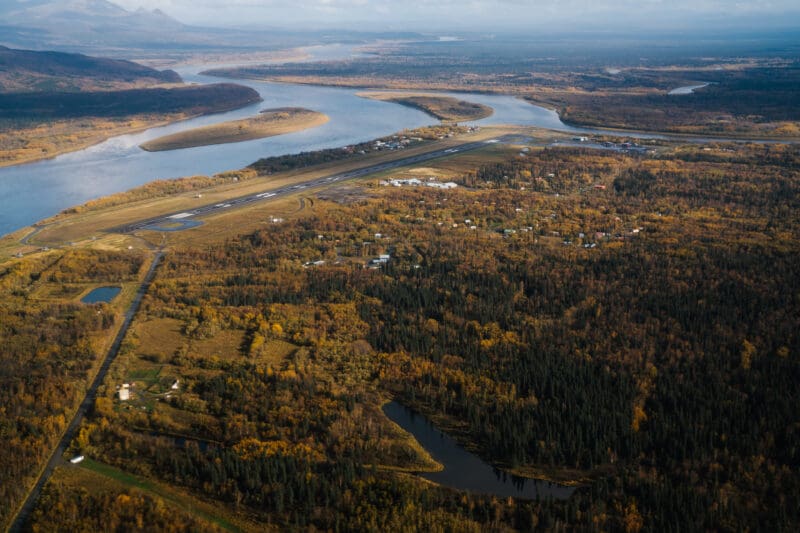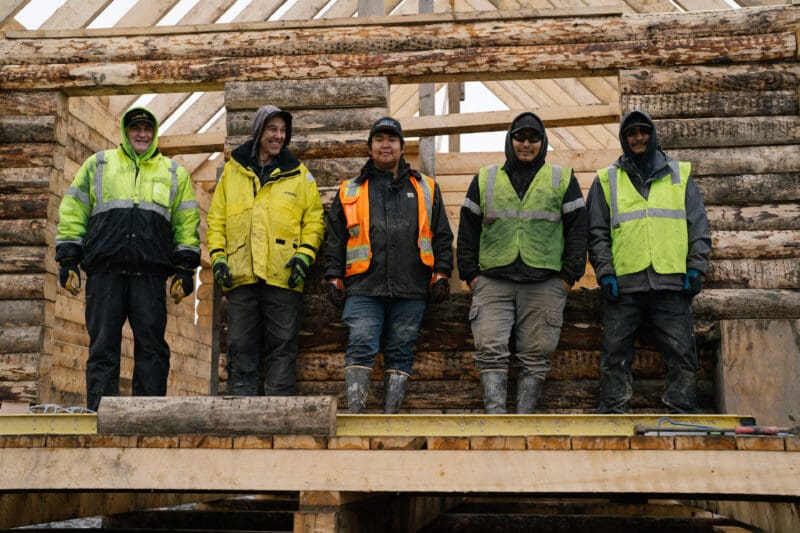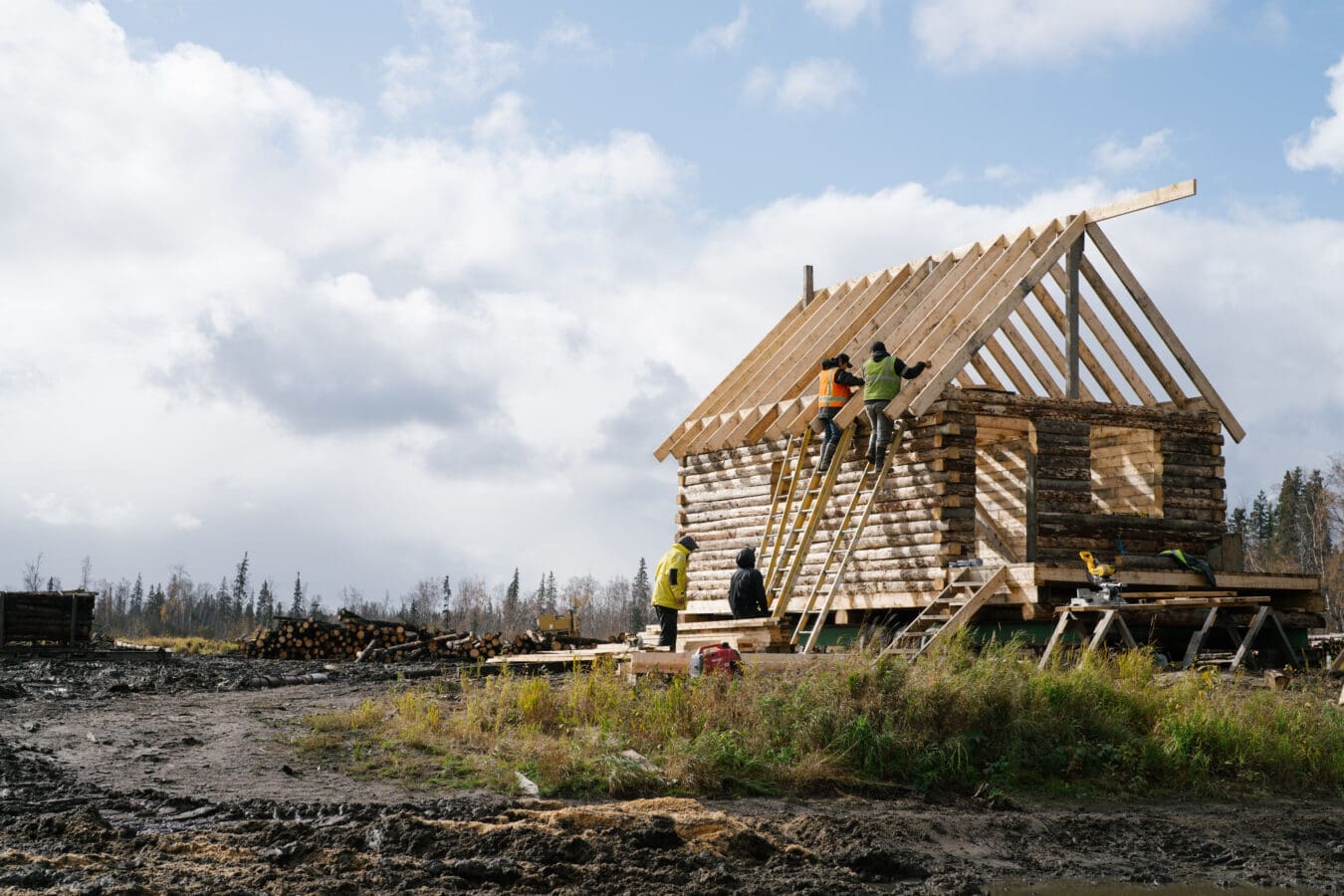Fish Wheel, the nonprofit arm of The Kuskokwim Corporation (TKC), is developing a multifaceted solution to the Middle Kuskokwim’s housing shortage by designing, sourcing, and building energy-efficient housing with locally sourced lumber.
Harvest to Home
 The Kuskokwim River is a vital thoroughfare for the people who live along it. People pass through dense forests of willow, birch and spruce as they travel up and down the river to visit family or friends, go to basketball games in nearby villages or to access ancestral fishing and hunting spots.
The Kuskokwim River is a vital thoroughfare for the people who live along it. People pass through dense forests of willow, birch and spruce as they travel up and down the river to visit family or friends, go to basketball games in nearby villages or to access ancestral fishing and hunting spots.
The region along the river from Stony River to Lower Kalskag is known as the Middle Kuskokwim. There are large stands of timber all around here, including between the villages of Napaimute and Aniak where spruce tree trunks can grow up to two feet in diameter. Napaimute even means “people of the trees.” Historically, people built their own houses using local trees that were processed in mills up and down the Kuskokwim River.
The timber industry in this part of Southwest Alaska is a far cry from the old-growth timber industry in Southeast Alaska. Trees here have been a crucial natural resource for the people living in this region for generations. The lumber has been used to build dwellings, for heat and to fuel steamboats.
Living in Southwest Alaska means steep shipping prices. For something like lumber, which has to be barged by river to Bethel, the cost could be in the thousands before taking shipping or the price of gas (~$9 a gallon) into consideration. In the face of broken supply chains, building a house is not cheap, and the region needs thousands of homes to meet people’s needs. Right now, multi-generational households live in homes that aren’t suited for extended families, and younger people especially often have to move to urban areas to find adequate housing and jobs. At current building rates, the Association of Village Council Presidents Regional Housing Authority estimates that it will take 100-200 years to meet current housing needs, not to mention any future growth.

Finding affordable housing is a fundamental challenge for people living along the Kuskokwim River and a top priority of The Kuskokwim Corporation (TKC), the Alaska Native Village Corporation for the Middle Kuskokwim region. TKC is one of many Alaska Native Corporations formed under the 1971 Alaska Native Claims Settlement Act that transferred millions of acres of Alaska land into corporate ownership for the benefit of Alaska Native shareholders and was meant to stimulate economic development across Alaska. TKC’s efforts in the region are innovating ways to address the housing crisis, economic disparities, lack of access to in-region trainings and lower the overall cost of living.
 That’s where “Harvest to Home” comes in. Established by TKC Fish Wheel, the nonprofit arm of TKC, the initiative aims to build affordable energy efficient homes with locally sourced timber, creating a new sustainable economic industry and employing and training local people in the region.
That’s where “Harvest to Home” comes in. Established by TKC Fish Wheel, the nonprofit arm of TKC, the initiative aims to build affordable energy efficient homes with locally sourced timber, creating a new sustainable economic industry and employing and training local people in the region.
Traditionally, fish wheels harness the power of the Kuskokwim River to provide for the region’s people. The Indigenous engineered wooden structures have been in use on the Middle Kuskokwim for hundreds of years, turning with the current of the river, and catching fish for families and communities. In a similar way, TKC Fish Wheel is working to revitalize the region by bringing more resources and support to the Middle Kuskokwim. “Harvest to Home” received a wood innovation grant from the U.S. Forest Service to combine traditional knowledge of Elders in the region and engineering from the Cold Climate Housing Research Center and the National Renewable Science Laboratory to create a home design unique in Alaska. Think energy efficient LEGO-type design that is easy to assemble and allows for the entire tree to be utilized. The plan is to have the local workforce shape all aspects of the project for the benefit of shareholders, from cutting down trees to transporting, milling, building, and living in the homes.
“Our people will be trained every single step of the way,” said Jonathan Samuelson, who is TKC’s Vice President of Shareholder Services.





There will eventually be three models to choose from and the designs meet federal requirements for energy efficiency and will qualify for additional federal funding support. With fluctuating astronomical heating and electricity costs (Aniak’s electricity rate went up overnight by a $1 per kw in 2023) the project is already anticipating how to heat the homes with biomass from the lumber mill to reduce cost and to create a sustainable, no waste production cycle. The goal is to start by building 10 homes a year, eventually scaling up to 40 homes a year.
TKC is also simultaneously updating its natural resource policy and renewing its forest stewardship plan. “Harvest to Home” is inspiring TKC to ask vital questions around what sustainable management of the forest and timber will look like. For example, how can it target areas of timber that are at high risk for wildfire, while helping with fire protection and wildfire management? The hope is to eventually serve as a model for others across the region and the state, and to build dialogues around ways to revitalize communities and create sustainable local industries with local input and for the benefit of local community members.
The project already has funding secured for the mill design, and mill and assembly line equipment. The village of Red Devil was strategically chosen to be the site for the lumber mill because it’s downriver from big timber and has been struggling with employment, infrastructure and population since the local mercury mine closed in 1971. The school also closed about 12 years ago and the village needs updated water and sewage infrastructure.
“All of it comes down to the wellness and well-being of our people,” Samuelson said.
“All of it comes down to the wellness and well-being of our people,” Samuelson said. “This holistic approach is really trying to get back to being healthy and thriving, and part of that is meeting basic needs: housing, water, getting training and education. Our thing is trying to perpetuate culture. We’ve come a long way.”
The Middle Kuskokwim isn’t immune to the effects of the changing climate and increasing storms in Southwest Alaska. The village of Crooked Creek had a 100 year flood in 2011 and an even worse flood in 2023. On the heels of this, “Harvest to Home” will help the region build back stronger and faster in times of disaster.


Through TKC Fish Wheel, TKC is also committed to creating jobs beyond timber in the region. To support residents interested in professional training or other career opportunities, TKC set up a one-stop-shop: The Arviiq Regional Economic Development and Training Center in Aniak. The center opened at the beginning of 2022, and is one of the only centers of its kind in the region. Arviiq means “sharpening stone.” It’s located on the site of a former elementary school and is available to residents and shareholders alike at no cost. People can visit the center for any number of needs: resume help, veterinary clinics, applying for scholarships, connecting to job training, obtaining professional licenses, printing important documents and cultural workshops such as net mending, qaspeq making and caribou tufting. More vocational training and education is in the works, with the goal for dormitories, a computer lab, a metal and wood workshop and other workspaces.
“The center will bring training to the region, once we’re well equipped,” said TKC’s Shareholder Development Coordinator Adrian Boelens. “You don’t have to go to Anchorage or Bethel or leave home for an extended period of time – which I think drops the success rate. You’re not where you grew up or know how to live. Being on your home river, staying close to family, will help people be successful.”
"Being on your home river, staying close to family, will help people be successful.”


A major value of the Middle Kuskokwim is to help each other. According to TKC’s CEO Andrea Gusty, Native corporations are obligated to be more than just businesses.
“My vision for the future is that the people of the Middle Kuskokwim are successful in whatever they want to do – that they do not have roadblocks to basic necessities, like water, sewer, internet, housing and workforce development, and that they are able to pursue the lives that they want for their families,” Gusty said. “The people, our culture, our values are very unique, but they all really center on the idea that we are connected, that we help one another, that we value our traditions – and that provides solid foundation, solid roots for everything.”
Fish Wheel is the nonprofit arm of The Kuskokwim Corporation. Operating with grant support, the organization sources local timber, offers skill training for local residents, and builds energy-efficient houses to combat the housing shortage in rural Alaska. For more information about Harvest to Home, connect directly with TKC’s Vice President of Shareholder Services Jonathan Samuelson.
Words by Victoria Petersen.
Photography by Joshua Corbett.
Published October 26, 2023
